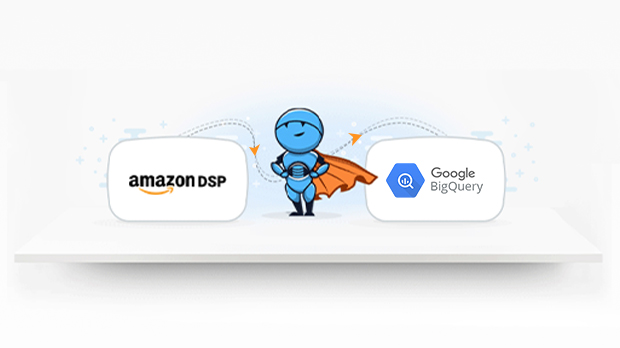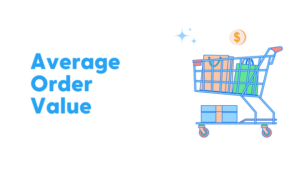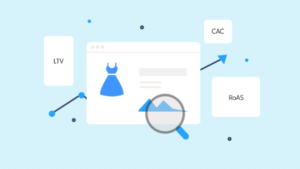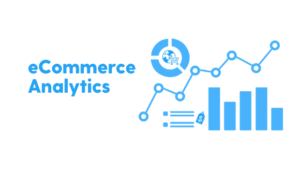Amazon DSP (Demand-Side Platform) advertises your brand’s ads on Amazon products like Kindle, Fire T.V, and Amazon Prime (OTT Platform) and offers the highest exposure to your merchandise. This platform generates a broad range of data, like, as creative placements, and ad campaigns. DSP displays from which creative ad placement, you are receiving the most customer traffic, and also calculates the customer retention rate. However, first, you must consolidate your data into a scalable, and robust data warehouse like Google BigQuery. This data warehouse offers high-speed SQL queries using Google’s infrastructure’s processing power. Replicating your Amazon DSP data to Google BigQuery summarizes your data and enhances your business performance. This article provides an overview and reasons to integrate Amazon DSP and Google BigQuery. And at last, there are two approaches to replicating your data. So, you can choose which method suits best for your business.
Why integrate Amazon DSP to Google BigQuery
Let us consider a simple example to determine why data integration to Google BigQuery is necessary. For understanding this example let’s calculate the business profits with this standard profit/loss formula:
Profits/Losses = Sales – Expenses.
For sales data, you can get the data from Amazon seller-central reports. And from the Amazon DSP dashboard, you can get the marketing expense data. There are other expenses like making costs, shipping costs, warehousing costs, and more. However, we will focus on the marketing expense data. It is due to Amazon DSP which focuses on marketing data. Thus, the final profit/loss equation will be:
Profits/Losses = (sales data from seller central – marketing expenses incurred in Amazon DSP Ads).
Now, the seller must put the sales and marketing expense data to an excel sheet or similar software for further analysis. However, if the analysts are manually pulling data from source to software and evaluating it, there are high chances that the result may have many errors. It could be a time-consuming process and lead to a time lag. Thus, results may not be in real-time. Things may become more difficult if you are selling on other eCommerce sites or using other ads like Google ads, or Youtube ads. So, when you are spending so much on marketing, then you would undoubtedly want to see all your data in one place from various platforms and analyze the data for a clear understanding of different aspects of your business.
Amazon DSP Overview
Amazon has built a DSP (Demand Side Platform). The platform enables those online sellers who are constantly seeking innovative ways to improve their conversion rates. Additionally, it also supports sellers to improve customer acquisition and retention rates. Amazon DSP helps you to endorse your products all over the web with high-quality audio and video product display ads.
Google BigQuery Overview
Google BigQuery is the first serverless data warehouse and is a cloud-based service. And this data warehouse is used by Fortune 500 enterprises and start-ups use. It automatically meets any demands of a query. The best part about using Google BigQuery is to immediately load data to the service as soon as you start using it. Therefore, a mechanism to load data in the data warehouse and the efficiency in writing SQL queries is the most crucial factor. Also, it enhances the storage and datasets in the background. Hence makes real-time analysis quicker and easier. Moreover, Google BigQuery service offers an excellent pricing model based on the amount of data processed by incoming queries, not on the storage or the computing capacity for processing queries.
How to Replicate Amazon DSP to Google BigQuery
Here are two approaches you can use to replicate Amazon DSP data to Google BigQuery. This will allow you to evaluate the pros and cons of both and choose the one that best suits your requirement.
Build your own Data Pipeline
This process needs a lot of experience and consumes a lot of time and manpower. The chances of errors are more due to multiple integrated steps to be executed one after the other. You need to extract data using Amazon DSP APIs & then connect it properly with the BigQuery data warehouse. This whole process to build a custom data pipeline requires regular intervention which makes it cumbersome.
Use Daton to integrate Amazon DSP to Google BigQuery
Integrating Amazon DSP to BigQuery with Daton is the fastest & easiest way to save your time and effort. Leveraging an eCommerce data pipeline like Daton significantly simplifies and accelerates the time it takes to build automated reporting.
Configuring data replication on Daton only takes a few minutes and a few clicks. Your analysts do not have to write any code or manage any infrastructure, yet you can get access to Amazon DSP data in a few hours.
Daton’s simple and easy-to-use interface allows analysts and developers to use UI elements to configure data replication from Amazon DSP to Google BigQuery.
Daton takes care of:
- Authentication
- Rate limits
- Sampling
- Historical data load
- Incremental data load
- Table creation, deletion, and reloads
- Refreshing access tokens
- Notifications
and many more important functions for data analysts to focus on analysis rather than worrying about data replication.
Steps to integrate Amazon DSP with Daton

- Sign in to Daton.
- Select Amazon DSP from the integrations page.
- Provide Integration Name, Replication Frequency, and History. The integration name would be used in creating tables for the integration and cannot be changed later.
- You will be redirected to Amazon DSP log in for authorizing Daton to extract data periodically.
- Post successful authentication, you will be prompted to choose from the list of available Amazon DSP accounts.
- Select required tables from the available list of tables.
- Then select all required fields for each table.
- Submit the integration.
Here are more reasons to explore Daton for Amazon DSP and Google BigQuery Integration
- Low Effort & Zero Maintenance – Daton automatically takes care of all the data replication processes and infrastructure once you sign up for a Daton account and configure the data sources. No need to manage infrastructure or write manual code.
- Faster integration – Amazon DSP to Google BigQuery is one of the integrations Daton can handle very conveniently and seamlessly. By following a few steps you can easily connect Amazon DSP to BigQuery.
- Enterprise-grade data pipeline at an unbeatable price to help every business become data-driven. Get started with a single integration today for just $10 and scale up as your data needs grow.
- Data consistency guarantee and an incredibly friendly customer support team ensure you can leave the data engineering to Daton and focus on analysis and insights!
- Support for all major cloud data warehouses including Google BigQuery, Snowflake, Amazon Redshift, Oracle Autonomous Data Warehouse, PostgreSQL, and more.
- Robust Scheduling Options: This allows you to schedule jobs based on their requirements using a simple configuration step.
- Flexible loading options allow you to optimize data loading behavior to maximize storage utilization and ease of querying.
- Enterprise-grade encryption gives your peace of mind.
- Support for 100+ data sources – In addition to Amazon DSP, Daton can extract data from a varied range of sources such as Sales and Marketing applications, Databases, Analytics platforms, Payment platforms, and much more.
- Daton, a fully managed modern ETL data pipeline gives you a fuss-free means to quickly and easily replicate your data from Amazon DSP to Google BigQuery.
For all sources, check our data connectors page.
Other Articles by Saras,













